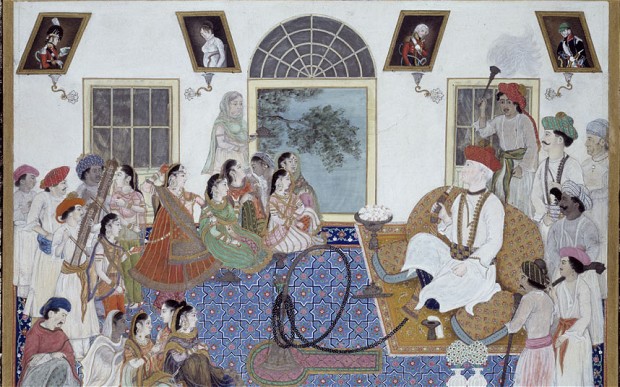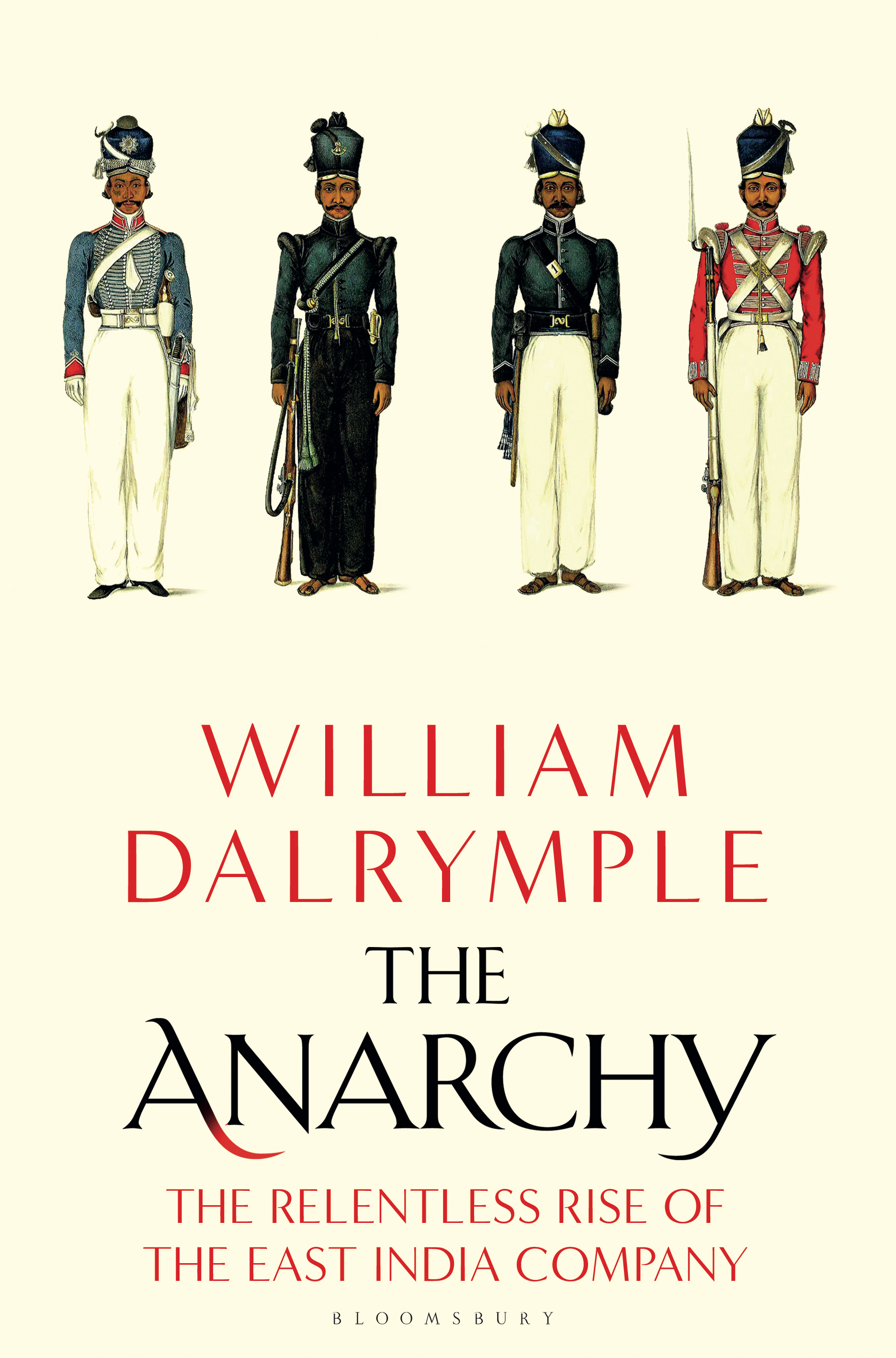William Dalrymple: The Anarchy review – masterly history of the first rogue corporation | reviews, news & interviews
William Dalrymple: The Anarchy review – masterly history of the first rogue corporation
William Dalrymple: The Anarchy review – masterly history of the first rogue corporation
Britain's privatised empire of loot in India – and its lessons for today

Serious historians don’t much care for counter-factual speculations. Readers, however, often enjoy them. So here’s mine. In 1780, the seemingly invincible forces of the East India Company had suffered a crushing defeat at Pollilur, west of Madras. It was inflicted by the well-drilled Mysore armies of Haidar Ali and his legendary warrior son, Tipu Sultan.
What if it had? The near-simultaneous loss of India and America might have thrust British mercantile imperialism back into a much smaller box for the next two centuries – as Indian setbacks did for the French version. And a Britain that remembered only a pocket-sized empire, lacking the glorious jewel in its crown, might not dream so easily of a split from its cross-Channel neighbours. Dalrymple does draw lessons for today from his learned, lively and supremely gripping chronicle of “the relentless rise of the East India Company”, as he explains how a commercial corporation, headquartered in a small building on Leadenhall Street, expanded into a near-sovereign power that “swiftly subdued or directly seized an entire subcontinent”. These lessons mostly have to do with the renewed impunity of financial and commercial clout in our own age of globalised capitalism. The East India Company, he argues, offers “history’s most ominous warning about the potential for the abuse of corporate power”. Reading his majestic narrative in the Britain of 2019, though, you recognise the way that guile, greed, luck and brute force blended almost by “happenchance” (a favourite Dalrymple word) to forge an imperial mind-set. It shaped how a huge proportion of Britons still think and feel about their country and its rightful place in the world. I would argue that thoughts, those feelings, are to a significant degree responsible for our current plight.
Although Dalrymple’s story begins with the foundation of the EIC in 1600, with its plans to rival the Dutch in the East Indies spice trade, the bulk of his book recounts the “Great Anarchy” of 18th-century India. One empire’s chaotic decline opened the way for another’s spectacular ascent. After the death of the puritan warmonger Aurangzeb in 1707, the Mughal Empire’s grip on India began to slip. Sibling rivalry, outside invasion (by Persian and Afghan chieftains) and the emergence of regional dynasties – above all the Marathas in the west, and the Bengali Nawabs in the east – created not so much a power-vacuum as an ever-shifting jigsaw. None of the pieces fitted securely together for long. As Dalrymple notes, local rulers could preside over prosperous and cultivated domains; their agriculture, manufactures, painting and poetry might still flourish as they had under the great Mughals. (In 1600, India produced an estimated 22.5 per cent of global GDP. Britain? 1.8 per cent).
But the empire’s violent fragmentation meant that a few tolerated foreign merchants – based, in the English case, first in Surat and Madras, later Bombay and Calcutta – could, if shrewd enough, acquire a leverage out of all proportion to their numbers and status. The catastrophic sack of Delhi in 1739 by a Persian invader, Nader Shah, and the entrenchment of Calcutta as focus of Company trade and wealth, accelerated the process. Then came the near-psychotic adventurism of Shropshire bookkeeper-turned-warlord Robert Clive. His ruthless audacity gave the Company its edge as a fighting force as well as a commercial giant. By 1757, when Clive defeated Siraj ud-Daula, the Nawab of Bengal, a joint-stock corporation was in a position to declare war on Indian princes.
 With strategic vision and unflagging fluency, Dalrymple keeps the many strands of his story seamlessly knitted. He clarifies the muddled landscape of late-Mughal politics as the gentle, noble and artistic emperor Shah Alam becomes a hapless plaything or prisoner of rival contenders (one, his former favourite and possible lover Ghulam Qadir, later blinded him and tortured his family). He paints richly detailed portraits of major players and key observers, from the dreamily poetic Emperor himself to the intellectual but vengeful Tipu Sultan, the brilliantly wily Maratha statesman Nana Phadnavis – and the tragic Warren Hastings. Effectively, the first British Governor-General of India, Hastings ruled well as an upright, sympathetic and pro-Indian leader. Yet he was accused by his enemies of gross corruption and, in 1788, famously arraigned in Parliament by Edmund Burke and Richard Sheridan. The only problem, as Dalrymple makes clear, was that Parliament “had impeached the wrong man”. Almost any other grasping “nabob” except Hastings should have stood in the Westminster dock.
With strategic vision and unflagging fluency, Dalrymple keeps the many strands of his story seamlessly knitted. He clarifies the muddled landscape of late-Mughal politics as the gentle, noble and artistic emperor Shah Alam becomes a hapless plaything or prisoner of rival contenders (one, his former favourite and possible lover Ghulam Qadir, later blinded him and tortured his family). He paints richly detailed portraits of major players and key observers, from the dreamily poetic Emperor himself to the intellectual but vengeful Tipu Sultan, the brilliantly wily Maratha statesman Nana Phadnavis – and the tragic Warren Hastings. Effectively, the first British Governor-General of India, Hastings ruled well as an upright, sympathetic and pro-Indian leader. Yet he was accused by his enemies of gross corruption and, in 1788, famously arraigned in Parliament by Edmund Burke and Richard Sheridan. The only problem, as Dalrymple makes clear, was that Parliament “had impeached the wrong man”. Almost any other grasping “nabob” except Hastings should have stood in the Westminster dock.
Crucially, Dalrymple follows the money, as the EIC drains the riches of fertile, industrious Bengal in alliance with complicit local elites, especially the Jagat Seth bankers (after all, the Company “spoke a language Indian financiers understood”). The sums involved are staggering. Not for nothing did the Hindustani slang term for plunder, "loot", enter the English language at this time. Clive’s world-changing victory at Plassey in 1757 alone brought him a one-off prize of £25 million (in today’s values) and annual revenues of £3 million from an estate. Before 1799, when the EIC finally vanquished Tipu Sultan, it held sway only over 9.3 per cent of Indian lands. Yet its extractive rapacity generated around half of all Britain’s foreign trade earnings. In 1765, the Emperor was forced to sign the “Diwani” that gave the Company full control of tax revenues in Bengal, Bihar and Orissa. At this “transformative, revolutionary moment”, the London corporation became a kind of state, an “empire within an empire”.
The Anarchy also traces the courses of campaigns and battles all over India. It nimbly keeps track of bloody and bizarre clashes from Punjab to Cochin, as Marathas, Bengalis and Avadhis try to rescue the Mughal “Peacock Throne” from the mafia-like protection of the EIC and stem the advance of the “hat-wearing” Europeans. Dalrymple makes brilliant use of contemporary sources. He knows how and when to step back and let extended quotations – many taken from the great Mughal historian Ghulam Hussain Khan – tell hair-raising yarns of glory, treachery and cruelty on every side. Indian thinkers such as Khan saw rapidly and lucidly that internecine divisions had opened a fatal chink in their empire’s armour that the “hat-wearers” could, and would, exploit. Nana Phadnavis found them “adept at the art of creating insidious differences”, while Tipu saw that “Wherever they fix their talons they contrive… to work themselves into the whole management of affairs”.
 Charm as well as cruelty served to swell the Company coffers. Its servants befriended, loved and even married the people among whom they lived and worked: by the 1790s, “one in three British men in India were cohabiting with Indian women”. (Pictured above, Delhi official Sir David Ochterlony in his Indian household). Its scholars learned and celebrated Indian languages and their literatures. Hastings in particular set in train reforms that did genuine and lasting good. Yet the imperative of “plunder”, with the EIC shareholders the ultimate beneficiaries of every corporate deed, never wavered for a day. The “business enterprise” from Leadenhall Street may have grown into “an autonomous imperial power”. No matter: the private avarice of traders who dubbed themselves “the grandest society of merchants in the Universe” trumped every wider view. Dalrymple calls the Company’s conquest of much of India – sealed by the capture of Delhi from the French-supported Marathas in 1803 – “the supreme act of corporate violence in world history”.
Charm as well as cruelty served to swell the Company coffers. Its servants befriended, loved and even married the people among whom they lived and worked: by the 1790s, “one in three British men in India were cohabiting with Indian women”. (Pictured above, Delhi official Sir David Ochterlony in his Indian household). Its scholars learned and celebrated Indian languages and their literatures. Hastings in particular set in train reforms that did genuine and lasting good. Yet the imperative of “plunder”, with the EIC shareholders the ultimate beneficiaries of every corporate deed, never wavered for a day. The “business enterprise” from Leadenhall Street may have grown into “an autonomous imperial power”. No matter: the private avarice of traders who dubbed themselves “the grandest society of merchants in the Universe” trumped every wider view. Dalrymple calls the Company’s conquest of much of India – sealed by the capture of Delhi from the French-supported Marathas in 1803 – “the supreme act of corporate violence in world history”.
In the end, that selfishness undid its rule. As Richard Wellesley – brother of Arthur, the future Duke of Wellington, who was tempered by his tough battles in India – took over as Governor General, the process of reining in the over-mighty merchants had begun. Wellesley thought of governing India “not as a corporate but a state enterprise”. After Delhi fell, with the aged “chessboard king” Shah Alam again a British puppet, the stage was set for the emergence of the Raj proper as a wholly nationalised project. Not until 1859, however, after the great uprising known by imperialist diehards as the “Mutiny”, did the Company formally expire as the agent of British authority in India. At the end of this wonderfully absorbing and salutary history, Dalrymple leaves us to decide whether the unaccountable Facebooks and Googles of today echo the outrageous impunity of “the first great multinational corporation, and the first to run amok”. We can be sure about the survival of its name. The “East India Company” brand now belongs to “two brothers from Kerala”, who run a gourmet deli in Mayfair.
- The Anarchy: The Relentless Rise of the East India Company by William Dalrymple (Bloomsbury, £25)
The future of Arts Journalism
You can stop theartsdesk.com closing!
We urgently need financing to survive. Our fundraising drive has thus far raised £49,000 but we need to reach £100,000 or we will be forced to close. Please contribute here: https://gofund.me/c3f6033d
And if you can forward this information to anyone who might assist, we’d be grateful.

Subscribe to theartsdesk.com
Thank you for continuing to read our work on theartsdesk.com. For unlimited access to every article in its entirety, including our archive of more than 15,000 pieces, we're asking for £5 per month or £40 per year. We feel it's a very good deal, and hope you do too.
To take a subscription now simply click here.
And if you're looking for that extra gift for a friend or family member, why not treat them to a theartsdesk.com gift subscription?
more Books
 'We are bowled over!' Thank you for your messages of love and support
Much-appreciated words of commendation from readers and the cultural community
'We are bowled over!' Thank you for your messages of love and support
Much-appreciated words of commendation from readers and the cultural community
 Thomas Pynchon - Shadow Ticket review - pulp diction
Thomas Pynchon's latest (and possibly last) book is fun - for a while
Thomas Pynchon - Shadow Ticket review - pulp diction
Thomas Pynchon's latest (and possibly last) book is fun - for a while
 Justin Lewis: Into the Groove review - fun and fact-filled trip through Eighties pop
Month by month journey through a decade gives insights into ordinary people’s lives
Justin Lewis: Into the Groove review - fun and fact-filled trip through Eighties pop
Month by month journey through a decade gives insights into ordinary people’s lives
 Joanna Pocock: Greyhound review - on the road again
A writer retraces her steps to furrow a deeper path through modern America
Joanna Pocock: Greyhound review - on the road again
A writer retraces her steps to furrow a deeper path through modern America
 Mark Hussey: Mrs Dalloway - Biography of a Novel review - echoes across crises
On the centenary of the work's publication an insightful book shows its prescience
Mark Hussey: Mrs Dalloway - Biography of a Novel review - echoes across crises
On the centenary of the work's publication an insightful book shows its prescience
 Frances Wilson: Electric Spark - The Enigma of Muriel Spark review - the matter of fact
Frances Wilson employs her full artistic power to keep pace with Spark’s fantastic and fugitive life
Frances Wilson: Electric Spark - The Enigma of Muriel Spark review - the matter of fact
Frances Wilson employs her full artistic power to keep pace with Spark’s fantastic and fugitive life
 Elizabeth Alker: Everything We Do is Music review - Prokofiev goes pop
A compelling journey into a surprising musical kinship
Elizabeth Alker: Everything We Do is Music review - Prokofiev goes pop
A compelling journey into a surprising musical kinship
 Natalia Ginzburg: The City and the House review - a dying art
Dick Davis renders this analogue love-letter in polyphonic English
Natalia Ginzburg: The City and the House review - a dying art
Dick Davis renders this analogue love-letter in polyphonic English
 Tom Raworth: Cancer review - truthfulness
A 'lost' book reconfirms Raworth’s legacy as one of the great lyric poets
Tom Raworth: Cancer review - truthfulness
A 'lost' book reconfirms Raworth’s legacy as one of the great lyric poets
 Ian Leslie: John and Paul - A Love Story in Songs review - help!
Ian Leslie loses himself in amateur psychology, and fatally misreads The Beatles
Ian Leslie: John and Paul - A Love Story in Songs review - help!
Ian Leslie loses himself in amateur psychology, and fatally misreads The Beatles
 Samuel Arbesman: The Magic of Code review - the spark ages
A wide-eyed take on our digital world can’t quite dispel the dangers
Samuel Arbesman: The Magic of Code review - the spark ages
A wide-eyed take on our digital world can’t quite dispel the dangers
 Zsuzsanna Gahse: Mountainish review - seeking refuge
Notes on danger and dialogue in the shadow of the Swiss Alps
Zsuzsanna Gahse: Mountainish review - seeking refuge
Notes on danger and dialogue in the shadow of the Swiss Alps

Add comment